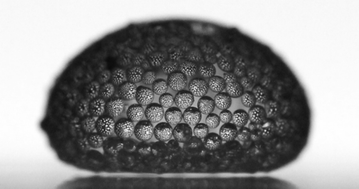Organization of microbeads in Leidenfrost drops†
Abstract
We investigated the organization of micrometric hydrophilic beads (glass or basalt) immersed in Leidenfrost drops. Starting from a large volume of water compared to the volume of the beads, while the liquid evaporates, we observed that the grains are eventually trapped at the interface of the droplet and accumulate. At a moment, the grains entirely cover the droplet. We measured the surface area at this moment as a function of the total mass of particles inserted in the droplet. We concluded that the grains form a monolayer around the droplet assuming (i) that the packing of the beads at the surface is a random close packing and (ii) that the initial surface of the drop is larger than the maximum surface that the beads can cover. Regarding the evaporation dynamics, the beads are found to reduce the evaporation rate of the drop. The slowdown of the evaporation is interpreted as being the consequence of the dewetting of the particles located at the droplet interface which makes the effective surface of evaporation smaller. As a matter of fact, contact angles of the beads with the water deduced from the evaporation rates are consistent with contact angles of beads directly measured at a flat air–water interface of water in a container.


 Please wait while we load your content...
Please wait while we load your content...